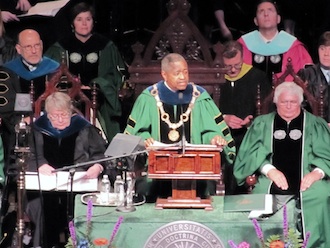Low Light Photography discussed by club
By Rex Dolby

The Van Wert Photography Club’s topic of discussion last Thursday was “Low Light Photography”. Various members brought some of their pictures on thumb drives, which stimulated comments and observations about the pictures and the subject in general.
Mike Taylor had a unique shot taken inside a barn that had fallen into disrepair. The sun cast shadows from the rafters onto the interior wall and in other places the blue sky was visible. Unless you know the owner, it is a good idea to get permission and/or let the sheriff’s department know of your intent if you plan to enter such a structure.
Mike also had some lightning pictures from a recent storm that occurred over Van Wert. In most cases you need a tripod and the capability of locking the shutter open to get one or more streaks. However, placing a camera with a metal body and lens on a metal tripod out in the open during an impressive lighting display may be screaming for trouble!
Generally, if you count the seconds between the flash and boom, you have an indication how many miles away the lighting is. Some sources say, “If you can hear thunder, get to shelter.” Others say you’re fairly safe at 30 miles, but as the distance closes the danger increases. Inside 20 miles it is wise to wait till the storm passes or shoot from a sheltered area. It’d be good to keep this information in mind the next time you attempt to photograph lightning strikes.
Taylor’s full moon pictures were equally impressive. The key here is to focus tightly and under expose or use a lower exposure compensation setting, because the dark night sky will call for a higher average reading than what you need.
Factors such as increasing the ISO setting to 800 or more, having a lens with a high, light-gathering capability and image stabilization, using spot metering, selecting a small area for auto-focusing, and holding the camera as securely as possible will all increase the chances of getting a good picture without a tripod or monopod.
Another “rule” is: when selecting shutter speed, it should not be slower than the inverse of the mm of the lens. (a 50mm lens would call for a minimum 1/50th of a second shutter speed) Shooting a waterfall at a slower speed is permissible or to achieve other photographic effects.
Barb Jewett had good night shots of Chicago taken while on a night cruise on Lake Michigan just outside the city. Hubby, Stuart, exhibited photos taken during various concerts that were rather impressive.
The club was pleased to welcome visitors Rick and Lindsay McCoy to the meeting and hopes to see them back often.
The club’s next regularly scheduled meeting is set for July 9 at 7 p.m. at 114 S. Race St.
POSTED: 06/17/15 at 1:45 pm. FILED UNDER: Camera Club News







